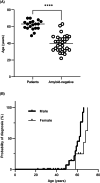Ser77Tyr transthyretin amyloidosis in Israel: Initial manifestations and diagnostic features
- PMID: 36772971
- PMCID: PMC10109316
- DOI: 10.1002/acn3.51741
Ser77Tyr transthyretin amyloidosis in Israel: Initial manifestations and diagnostic features
Abstract
Objective: Amyloidosis due to the transthyretin Ser77Tyr mutation (ATTRS77Y) is a rare autosomal-dominant disorder, characterized by carpal-tunnel syndrome, poly- and autonomic-neuropathy, and cardiomyopathy. However, related symptoms and signs are often nonspecific and confirmatory tests are required. We describe the age and frequency of early symptoms and diagnostic features among individuals of Jewish Yemenite descent in Israel.
Methods: Records of mutation carriers were retrospectively reviewed. ATTRS77Y diagnosis was defined by the presence of amyloid in tissue and/or amyloid-related cardiomyopathy.
Results: We identified the Ser77Tyr mutation at the heterozygous state in 19 amyloidosis patients (mean age at diagnosis: 62 ± 5.7 years, range 49-70) and 30 amyloid-negative carriers. The probability for disease diagnosis increased from 4.4% at age 49 to 100% at 70 and occurred earlier in males. Initial symptoms preceded diagnosis by 5 ± 3.8 years (range 0-12) and were commonly sensory changes in the extremities. Erectile dysfunction predated these in 8/13 (62%) males. In two patients cardiac preceded neurological symptoms. Two patients declined symptoms. Electrophysiological studies near the time of diagnosis indicated a median neuropathy at the wrist in 18/19 (95%) and polyneuropathy in 13/19 (68%). Skin biopsy revealed epidermal denervation in 15/16 (94%) patients. Cardiomyopathy was identified in 16/19 (84%). Sensory complaints or epidermal denervations were present in 17/30 (57%) of amyloid-negative carriers and co-occurred in 10/30 (33%).
Interpretation: ATTRS77Y symptoms commonly occur after age 50, but may begin earlier. Median neuropathy, skin denervation and cardiomyopathy are frequently identified. Symptoms may be absent in patients and common in amyloid-negative carriers.
© 2023 The Authors. Annals of Clinical and Translational Neurology published by Wiley Periodicals LLC on behalf of American Neurological Association.
Conflict of interest statement
This is to acknowledge that A. Dori received consultancy fees, honoraria for lectures and travel meeting attendance support from Pfizer, and investigator‐initiated research grant support from Pfizer and Alnylam Pharmaceuticals industry (companies that manufacture the drugs described is in this study). Additionally, A. Dori is the local site's primary investigator in Pfizer's Transthyretin Amyloidosis Outcome Survey (THAOS) and Alnylam's Global Observational Study of Patients with Transthyretin‐Mediated Amyloidosis (ConTTRibute) study. M. Arad received lectures honoraria and fees for participation in an advisory board from Pfizer.
Figures



References
-
- Sekijima Y. Hereditary transthyretin amyloidosis. In: Adam MP, Ardinger HH, Pagon RA, et al., eds. GeneReviews®. University of Washington, Seattle; 2021:1993‐2021 https://www.ncbi.nlm.nih.gov/books/NBK1194/ - PubMed
Publication types
MeSH terms
Substances
Supplementary concepts
LinkOut - more resources
Full Text Sources
Medical
Research Materials

